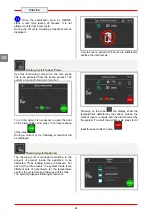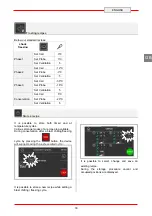
38
ENGLISH
GB
6. CLEANING
AND
MAINTENANCE
6.1.
Recommendations for Cleaning and Maintenance
!
Activate all envisioned safety devices before
carrying out any maintenance interventions. In
particular, deactivate the electrical power supply
using the automatic isolating switch.
6.2. Routine
Maintenance
Routine maintenance consists of daily cleaning of
all the parts which can come into contact with
foodstuffs and the periodic maintenance of the
burners, nozzles and draining pipes.
Correct maintenance allows the user to maximise
performance levels and operating life and
constantly maintain safety requirements.
Do not spray the appliance with direct jets of
water or using high pressure appliances.
Do not use iron wool, brushes or scrapers to clean
the stainless steel as ferrous particles could be
deposited which, on oxidising, could lead to rust.
To remove hardened residues, use wooden or
plastic spatulas or abrasive rubber pads.
During long periods of inactivity, spread a
protective layer on all stainless steel surfaces by
wiping them with a cloth soaked in Vaseline oil
and airing the rooms periodically.
!
Do not use products which contain
substances which are harmful and dangerous for
personal health (solvents, petrol etc.).
At the end of the day
it is advisable to clean:
the cooling compartment
the
appliance.
6.3.
Extraordinary Maintenance 10T and 14T
Have the following operations carried out
periodically
by specialised staff:
Check the perfect sealing of the door
gaskets and replace them if necessary.
Check that the electric connections have
not loosened.
Check the efficiency of the heating
element resistance
Check functioning of the board and
probes.
Check the efficiency of the electrical
system.
Clean the evaporator.
Clean the condenser.
















































